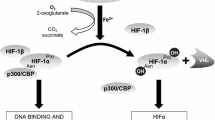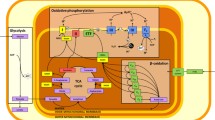Abstract
Hypoxia induces a loss of skeletal muscle mass and alters myogenesis in vitro, but whether it affects muscle regeneration in vivo following injury remains to be elucidated. We hypothesized that hypoxia would impair the recovery of muscle mass during regeneration. To test this hypothesis, the soleus muscle of female rats was injured by notexin and allowed to recover for 3, 7, 14, and 28 days under normoxia or hypobaric hypoxia (5,500 m) conditions. Hypoxia impaired the formation and growth of new myofibers and enhanced the loss of muscle mass during the first 7 days of regeneration, but did not affect the final recovery of muscle mass at 28 days. The impaired regeneration under hypoxic conditions was associated with a blunted activation of mechanical target of rapamycin (mTOR) signaling as assessed by p70S6K and 4E-BP1 phosphorylation that was independent of Akt activation. The decrease in mTOR activity with hypoxia was consistent with the increase in AMP-activated protein kinase activity, but not related to the change in regulated in development and DNA response 1 protein content. Hypoxia increased the mRNA levels of the atrogene muscle ring finger-1 after 7 days of regeneration, though muscle atrophy F box transcript levels remained unchanged. The increase in MyoD and myogenin mRNA expression with regeneration was attenuated at 7 days with hypoxia. In conclusion, our results support the notion that the enhanced loss of muscle mass observed after 1 week of regeneration under hypoxic conditions could mainly result from the impaired formation and growth of new fibers resulting from a reduction in protein synthesis and satellite cell activity.





Similar content being viewed by others
References
Bigard X, Sanchez H, Birot O, Serrurier B (2000) Myosin heavy chain composition of skeletal muscles in young rats growing under hypobaric hypoxia conditions. J Appl Physiol 88(2):479–486
Bodine SC, Latres E, Baumhueter S, Lai VK, Nunez L, Clarke BA, Poueymirou WT, Panaro FJ, Na E, Dharmarajan K, Pan ZQ, Valenzuela DM, DeChiara TM, Stitt TN, Yancopoulos GD, Glass DJ (2001) Identification of ubiquitin ligases required for skeletal muscle atrophy. Science 294(5547):1704–1708
Cai D, Frantz JD, Tawa NE Jr, Melendez PA, Oh BC, Lidov HG, Hasselgren PO, Frontera WR, Lee J, Glass DJ, Shoelson SE (2004) IKKbeta/NF-kappaB activation causes severe muscle wasting in mice. Cell 119(2):285–298
Chaillou T, Koulmann N, Simler N, Meunier A, Serrurier B, Chapot R, Peinnequin A, Beaudry M, Bigard X (2012) Hypoxia transiently affects skeletal muscle hypertrophy in a functional overload model. Am J Physiol Regul Integr Comp Physiol 302(5):R643–654
Chaillou T, Malgoyre A, Banzet S, Chapot R, Koulmann N, Pugniere P, Beaudry M, Bigard X, Peinnequin A (2011) Pitfalls in target mRNA quantification for real-time quantitative RT-PCR in overload-induced skeletal muscle hypertrophy. Physiol Genom 43(4):228–235
Charge SB, Rudnicki MA (2004) Cellular and molecular regulation of muscle regeneration. Physiol Rev 84(1):209–238
de Theije C, Costes F, Langen RC, Pison C, Gosker HR (2011) Hypoxia and muscle maintenance regulation: implications for chronic respiratory disease. Curr Opin Clin Nutr Metab Care 14(6):548–553
Deldicque L, Atherton P, Patel R, Theisen D, Nielens H, Rennie MJ, Francaux M (2008) Decrease in Akt/PKB signalling in human skeletal muscle by resistance exercise. Eur J Appl Physiol 104(1):57–65
DeYoung MP, Horak P, Sofer A, Sgroi D, Ellisen LW (2008) Hypoxia regulates TSC1/2-mTOR signaling and tumor suppression through REDD1-mediated 14-3-3 shuttling. Genes Dev 22(2):239–251
Di Carlo A, De Mori R, Martelli F, Pompilio G, Capogrossi MC, Germani A (2004) Hypoxia inhibits myogenic differentiation through accelerated MyoD degradation. J Biol Chem 279(16):16332–16338
Favier FB, Costes F, Defour A, Bonnefoy R, Lefai E, Bauge S, Peinnequin A, Benoit H, Freyssenet D (2010) Downregulation of Akt/mammalian target of rapamycin pathway in skeletal muscle is associated with increased REDD1 expression in response to chronic hypoxia. Am J Physiol Regul Integr Comp Physiol 298(6):R1659–1666
Fink E, Fortin D, Serrurier B, Ventura-Clapier R, Bigard AX (2003) Recovery of contractile and metabolic phenotypes in regenerating slow muscle after notexin-induced or crush injury. J Muscle Res Cell Motil 24(7):421–429
Garg PK, Liu K, Ferrucci L, Guralnik JM, Criqui MH, Tian L, Sufit R, Nishida T, Tao H, Liao Y, McDermott MM (2011) Lower extremity nerve function, calf skeletal muscle characteristics, and functional performance in peripheral arterial disease. J Am Geriatr Soc 59(10):1855–1863
Ge Y, Wu AL, Warnes C, Liu J, Zhang C, Kawasome H, Terada N, Boppart MD, Schoenherr CJ, Chen J (2009) mTOR regulates skeletal muscle regeneration in vivo through kinase-dependent and kinase-independent mechanisms. Am J Physiol Cell Physiol 297(6):C1434–1444
Glass DJ (2005) Skeletal muscle hypertrophy and atrophy signaling pathways. Int J Biochem Cell Biol 37(10):1974–1984
Greco S, De Simone M, Colussi C, Zaccagnini G, Fasanaro P, Pescatori M, Cardani R, Perbellini R, Isaia E, Sale P, Meola G, Capogrossi MC, Gaetano C, Martelli F (2009) Common micro-RNA signature in skeletal muscle damage and regeneration induced by Duchenne muscular dystrophy and acute ischemia. Faseb J 23(10):3335–3346
Gutierrez JM, Ownby CL (2003) Skeletal muscle degeneration induced by venom phospholipases A2: insights into the mechanisms of local and systemic myotoxicity. Toxicon 42(8):915–931
Gwinn DM, Shackelford DB, Egan DF, Mihaylova MM, Mery A, Vasquez DS, Turk BE, Shaw RJ (2008) AMPK phosphorylation of raptor mediates a metabolic checkpoint. Mol Cell 30(2):214–226
Hardie DG (2007) AMP-activated/SNF1 protein kinases: conserved guardians of cellular energy. Nat Rev Mol Cell Biol 8(10):774–785
Harris JB (2003) Myotoxic phospholipases A2 and the regeneration of skeletal muscles. Toxicon 42(8):933–945
Harris JB, Johnson MA, Karlsson E (1974) Proceedings: histological and histochemical aspects of the effect of notexin on rat skeletal muscle. Br J Pharmacol 52(1):152P
Hayot M, Rodriguez J, Vernus B, Carnac G, Jean E, Allen D, Goret L, Obert P, Candau R, Bonnieu A (2011) Myostatin up-regulation is associated with the skeletal muscle response to hypoxic stimuli. Mol Cell Endocrinol 332(1–2):38–47
Heinemeier KM, Olesen JL, Schjerling P, Haddad F, Langberg H, Baldwin KM, Kjaer M (2007) Short-term strength training and the expression of myostatin and IGF-I isoforms in rat muscle and tendon: differential effects of specific contraction types. J Appl Physiol 102(2):573–581
Horman S, Browne G, Krause U, Patel J, Vertommen D, Bertrand L, Lavoinne A, Hue L, Proud C, Rider M (2002) Activation of AMP-activated protein kinase leads to the phosphorylation of elongation factor 2 and an inhibition of protein synthesis. Curr Biol 12(16):1419–1423
Launay T, Hagstrom L, Lottin-Divoux S, Marchant D, Quidu P, Favret F, Duvallet A, Darribere T, Richalet JP, Beaudry M (2010) Blunting effect of hypoxia on the proliferation and differentiation of human primary and rat L6 myoblasts is not counteracted by Epo. Cell Prolif 43(1):1–8
Liu L, Cash TP, Jones RG, Keith B, Thompson CB, Simon MC (2006) Hypoxia-induced energy stress regulates mRNA translation and cell growth. Mol Cell 21(4):521–531
Majmundar AJ, Skuli N, Mesquita RC, Kim MN, Yodh AG, Nguyen-McCarty M, Simon MC (2012) O(2) regulates skeletal muscle progenitor differentiation through phosphatidylinositol 3-kinase/AKT signaling. Mol Cell Biol 32(1):36–49
Mancini DM, Walter G, Reichek N, Lenkinski R, McCully KK, Mullen JL, Wilson JR (1992) Contribution of skeletal muscle atrophy to exercise intolerance and altered muscle metabolism in heart failure. Circulation 85(4):1364–1373
Mauro A (1961) Satellite cell of skeletal muscle fibers. J Biophys Biochem Cytol 9:493–495
Miyabara EH, Conte TC, Silva MT, Baptista IL, Bueno C Jr, Fiamoncini J, Lambertucci RH, Serra CS, Brum PC, Pithon-Curi T, Curi R, Aoki MS, Oliveira AC, Moriscot AS (2010) Mammalian target of rapamycin complex 1 is involved in differentiation of regenerating myofibers in vivo. Muscle Nerve 42(5):778–787
Nader GA (2005) Molecular determinants of skeletal muscle mass: getting the “AKT” together. Int J Biochem Cell Biol 37(10):1985–1996
Paulding WR, Czyzyk-Krzeska MF (2000) Hypoxia-induced regulation of mRNA stability. Adv Exp Med Biol 475:111–121
Pause A, Belsham GJ, Gingras AC, Donze O, Lin TA, Lawrence JC Jr, Sonenberg N (1994) Insulin-dependent stimulation of protein synthesis by phosphorylation of a regulator of 5′-cap function. Nature 371(6500):762–767
Ren H, Accili D, Duan C (2010) Hypoxia converts the myogenic action of insulin-like growth factors into mitogenic action by differentially regulating multiple signaling pathways. Proc Natl Acad Sci U S A 107(13):5857–5862
Rose MS, Houston CS, Fulco CS, Coates G, Sutton JR, Cymerman A (1988) Operation Everest. II: nutrition and body composition. J Appl Physiol 65(6):2545–2551
Sandri M (2008) Signaling in muscle atrophy and hypertrophy. Physiology (Bethesda) 23:160–170
Schmutz S, Dapp C, Wittwer M, Durieux AC, Mueller M, Weinstein F, Vogt M, Hoppeler H, Fluck M (2010) A hypoxia complement differentiates the muscle response to endurance exercise. xp Physio 95(6):723–735
Stitt TN, Drujan D, Clarke BA, Panaro F, Timofeyva Y, Kline WO, Gonzalez M, Yancopoulos GD, Glass DJ (2004) The IGF-1/PI3K/Akt pathway prevents expression of muscle atrophy-induced ubiquitin ligases by inhibiting FOXO transcription factors. Mol Cell 14(3):395–403
Theriault ME, Pare ME, Maltais F, Debigare R (2012) Satellite cells senescence in limb muscle of severe patients with COPD. PLoS One 7(6):e39124
Vandesompele J, De Preter K, Pattyn F, Poppe B, Van Roy N, De Paepe A, Speleman F (2002) Accurate normalization of real-time quantitative RT-PCR data by geometric averaging of multiple internal control genes. Genome Biol 3 (7): RESEARCH0034
Wood SC, Stabenau EK (1998) Effect of gender on thermoregulation and survival of hypoxic rats. Clin Exp Pharmacol Physiol 25(2):155–158
Yun Z, Lin Q, Giaccia AJ (2005) Adaptive myogenesis under hypoxia. Mol Cell Biol 25(8):3040–3055
Acknowledgments
We thank Corinne Grégoire, Rachel Chapot, Nadine Simler, and Bernard Serrurier for helpful technical assistance and Dr Andre Peinnequin for useful discussions about RT-qPCR analysis. This work was supported by a predoctoral fellowship from the Ministère de I'Enseignement Supérieur et de la Recherche to TC and by the Association Française contre les Myopathies (grant number 13955 to MB and XB).
Author information
Authors and Affiliations
Corresponding author
Rights and permissions
About this article
Cite this article
Chaillou, T., Koulmann, N., Meunier, A. et al. Ambient hypoxia enhances the loss of muscle mass after extensive injury. Pflugers Arch - Eur J Physiol 466, 587–598 (2014). https://doi.org/10.1007/s00424-013-1336-7
Received:
Revised:
Accepted:
Published:
Issue Date:
DOI: https://doi.org/10.1007/s00424-013-1336-7




